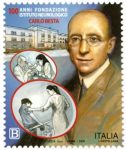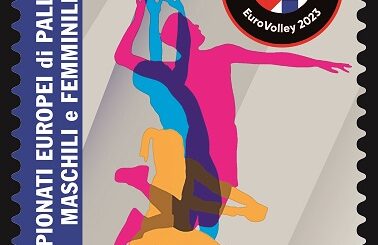POSTE ITALIANE – 44^ Emissione del 20 Dicembre 2018 – Fondazione I.R.C.C.S. Istituto Neurologico “Carlo Besta” in Milano
Titolo: Francobollo appartenente alla serie “Eccellenze del Sapere” dedicato alla Fondazione I.R.C.C.S. Istituto Neurologico “Carlo Besta” in Milano.
Il Ministero emette il 20 dicembre 2018 un francobollo ordinario appartenente alla serie tematica “le Eccellenze del sapere” dedicato alla Fondazione I.R.C.C.S. Istituto Neurologico “Carlo Besta” in Milano, nel centenario della fondazione, relativo al valore della tariffa B.
In Italia, un istituto di ricovero e cura a carattere scientifico (IRCCS) è un ospedale nel quale vengono svolte attività di ricerca clinica, nonché di gestione dei servizi sanitari, che in virtù del loro contributo alla ricerca ricevono finanziamenti pubblici. Gli “istituti di ricovero e cura a carattere scientifico” sono particolari aziende ospedaliere con natura giuridica diversa, pubblica o privata. La Fondazione IRCCS Carlo Besta, di rilievo nazionale, si configura quale Fondazione di partecipazione, nella quale assumono particolare rilevanza i soggetti rappresentati in seno al Consiglio di Amministrazione; la Fondazione Besta annovera tra i fondatori la Regione Lombardia,il Ministero della Salute e il Comune di Milano.
Carlo Besta nasce a Sondrio nel 1876 da Maria Morelli e Bartolomeo, medico condotto di Teglio, borgo della Valtellina. Inizia gli studi universitari nel 1894 come allievo di medicina dell’Università di Pavia e alunno del Collegio Ghislieri. Frequenta per un triennio l’Istituto di Patologia Speciale Medica sotto la guida del prof. Bernardino Silva al quale subentrerà, nell’ultimo anno di corso, il prof. Carlo Forlanini, che Besta seguirà come allievo dopo il trasferimento alla Clinica Medica Generale. Il 12 luglio 1900 consegue la laurea in Medicina e Chirurgia, ottenendo la votazione di 108/110, con una tesi dal titolo “I riflessi nei bambini affetti da elmintiasi”; l’elaborato verrà pubblicato, nel novembre 1900, sulla Gazzetta Medica di Torino.
I primi anni di attività
Nel 1901 svolge, per quindici mesi, l’attività di medico condotto in Valtellina, per trasferirsi poi all’Ospedale Psichiatrico di San Lazzaro a Reggio Emilia, inizialmente in qualità di medico praticante, in seguito di assistente. È probabilmente in questo istituto che Besta matura la vocazione di neurologo: le sue prime ricerche si basano sugli studi dell’istologia del tessuto nervoso, della fisiopatologia e della clinica dell’epilessia. Risale a questo periodo una serie di pubblicazioni di carattere sperimentale ed istopatologico apparse sulla Rivista Sperimentale di Freniatria. È membro, nel 1907, della Società Italiana di Neurologia. Nel gennaio dello stesso anno si trasferisce a Venezia all’Ospedale psichiatrico di San Servolo, con l’incarico di dirigere e organizzare il reparto “Osservazione”. Nel giugno 1907, dopo solo sei mesi di primariato a San Servolo, si trasferisce a Padova presso l’Istituto Psichiatrico e Neuropatologico e ottiene, nel maggio dell’anno successivo, la libera docenza in Clinica delle malattie nervose e mentali presso l’Università di Padova. Qui Besta si dà a studi anatomici e sperimentali che, consegnati alle stampe nel novembre del 1912, vengono pubblicati all’interno dell’Archiv für Psychiatrie und Nervenkrankheiten di Berlino l’anno successivo. Le pubblicazioni gli permettono di ottenere una certa notorietà: viene nominato, nel 1913, titolare della Clinica delle malattie nervose e mentali dell’Università di Messina.
Il periodo bellico e il trasferimento a Milano
Con lo scoppio della prima guerra mondiale sul fronte italo-austriaco, Besta è chiamato a dirigere l’Ospedale Militare di S. Ambrogio a Milano con il grado di Maggiore medico dell’esercito e consulente neurologo. Desideroso di raccogliere in un’unica sede i feriti di guerra del sistema nervoso, dirige dal 1915 al 1918 il Centro Neurochirurgico della Guastalla, nato anche per sua iniziativa. Egli si dedica allo studio e al trattamento dei cerebrolesi. Il 25 aprile 1925, in occasione della visita del sovrano Vittorio Emanuele III all’istituto, il Consiglio di Amministrazione delibera la costruzione di una nuova e più vasta sede: nel gennaio del 1932 viene inaugurato, sotto l’egida del sovrano, l’Istituto Neurologico Vittorio Emanuele III, modello insuperabile, per l’epoca, di collaborazione clinica nei campi della neurologia. Il 2 maggio 1932 l’attività sanitaria è allargata ai traumatizzati nervosi del lavoro e ai malati organici del sistema nervoso.
Gli ultimi anni e la morte
La carriera professionale di Besta viene arricchendosi, dal 1931 in poi, di numerosi e significativi riconoscimenti. Già socio corrispondente dell’Accademia Peloritana di Messina dal 1915 e socio corrispondente della Società Medico-Chirurgica di Bologna dal 1924, diviene vicepresidente dell’Accademia Medica Lombarda nel 1931, presidente della Società Italiana di Oto-neuro-oftalmologia nel 1933 (già membro ordinario dal 1926), membro del Comitato Nazionale per la Medicina nel 1934, componente alienista della Commissione Provinciale di Vigilanza sui manicomi e sugli alienati nel 1940 e viene nominato Ufficiale dell’Ordine della Corona d’Italia nell’aprile del 1932 da Vittorio Emanuele III e Cavaliere dell’Ordine dei Santi Maurizio e Lazzaro nel 1940. Dopo aver favorito tramite vari anni di attività scientifica la nascita della Neuroradiologia e della Neurochirurgia, Carlo Besta muore a Milano nella Clinica dell’Asilo evangelico all’età di 64 anni, debilitato dalla degenerazione cronica di un’ulcera che per lunghi anni lo aveva tormentato.
Gli studi sull’epilessia
Carlo Besta si è particolarmente interessato sin dalla laurea del problema dell’epilessia: ha eseguito ricerche sviluppate sulla base di scrupolose indagini semeiologiche, ha condotto studi assidui sui malati epilettici in coincidenza e in vicinanza delle crisi e nei periodi intervallari, evidenziando nella maggior parte dei casi asimmetrie funzionali degli emisferi cerebrali ed altri segni di patimento delle strutture nervose. Ha spinto la sua indagine ad illuminare i rapporti tra l’insorgenza e lo svolgimento delle manifestazioni comiziali in riferimento alla sede della lesione corticale e ha descritto un’epilessia frontale di carattere prevalentemente psichico. Gli studi sull’epilessia hanno portato Besta a mettere in luce l’estrema variabilità di alcune costanti biologiche, quali la pressione arteriosa o il potere coagulante del siero di sangue, in tali ammalati; sono stati svolti altri studi sulle manifestazioni emilaterali nell’epilessia essenziale e sulla sindrome di Bernard-Horner negli epilettici. Durante gli ultimi anni della sua vita si è inoltre occupato delle relazioni tra epilessia e tumore cerebrale, della chirurgia dell’epilessia e delle manifestazioni epilettiche bilaterali da lesioni unilaterali.
Gli studi sui malati di guerra
Nel periodo bellico, Besta ha studiato l’influenza che le lesioni parietali esplicavano nella funzione motoria: ha messo in evidenza disturbi nella direzione dei movimenti, nella capacità di mantenere determinati atteggiamenti volontari ad occhi bendati e disordini nel controllo e nella regolazione della tonicità, nonché del grado di tensione muscolare, necessari all’armonica esecuzione di atti volontari.
Gli studi sui tumori cerebrali
La pneumoencefalografia, la mielografia e l’arteriografia sono stati mezzi adeguati di conoscenza scientifica e diagnostica che hanno consentito la creazione, anche per merito di Besta, di un nuovo settore diagnostico, la Neuroradiologia. Per la diagnosi precoce dei tumori cerebrali Besta ritenne indispensabile l’esplorazione dell’apparato ventricolare mediante encefalografia e ventricolografia cerebrale; era, infatti, persuaso che tali indagini potessero svelare anche piccoli segni di lesione nervosa organica non identificabili mediante l’esame clinico ordinario. Si è inoltre occupato, negli ultimi anni della sua vita, della terapia dei nervi periferici in relazione al tumore parietale.
Title: Stamp belonging to the “Eccellenze del Sapere” series dedicated to the I.R.C.C.S. “Carlo Besta” Neurological Institute in Milan.
On 20 December 2018 the Ministry issued an ordinary stamp belonging to the thematic series “the Excellencies of knowledge” dedicated to the I.R.C.C.S. “Carlo Besta” Neurological Institute in Milan, on the centenary of the foundation, on the value of the tariff B.
In Italy, a scientific hospitalization and treatment institute (IRCCS) is a hospital where clinical research activities are carried out, as well as management of health services, which by virtue of their contribution to research receive public funding. The “scientific hospitalization and care institutions” are special hospitals with different legal, public or private nature. The IRCCS Carlo Besta Foundation, of national importance, is set up as a Foundation of participation, in which the subjects represented in the Board of Directors take on particular importance; The Besta Foundation counts among the founders the Lombardy Region, the Ministry of Health and the Municipality of Milan.
Carlo Besta was born in Sondrio in 1876 by Maria Morelli and Bartolomeo, a doctor from Teglio, a village in the Valtellina. He began his university studies in 1894 as a medical student at the University of Pavia and a student at the Collegio Ghislieri. He attended the Institute of Special Medical Pathology for three years under the guidance of prof. Bernardino Silva who will take over, in the last year of the course, prof. Carlo Forlanini, whom Besta will follow as a student after the transfer to the General Medical Clinic. On July 12, 1900, he graduated in Medicine and Surgery, obtaining the 108/110 mark, with a thesis entitled “Reflexes in children with helminthiasis”; the paper will be published in November 1900 in the Gazzetta Medica of Turin.
The first years of activity
In 1901 he worked for fifteen months as a doctor in Valtellina, then moved to the Psychiatric Hospital of San Lazzaro in Reggio Emilia, initially as a practicing physician, later as an assistant. It is probably in this institute that Besta matures the vocation of a neurologist: his first research is based on studies of the histology of the nervous tissue, of the pathophysiology and of the clinic of epilepsy. From this period a series of experimental and histopathological publications appeared in the Experimental Journal of Freniatria. He is a member of the Italian Society of Neurology in 1907. In January of the same year he moved to Venice to the Psychiatric Hospital of San Servolo, with the task of directing and organizing the “Observation” department. In June 1907, after only six months of primary school in San Servolo, he moved to Padua at the Psychiatric and Neuropathological Institute and obtained, in May of the following year, the free teaching in the Clinic of nervous and mental diseases at the University of Padua. Here Besta gives anatomical and experimental studies which, delivered to the press in November 1912, are published in the Archiv für Psychiatrie und Nervenkrankheiten in Berlin the following year. The publications allow him to gain a certain notoriety: in 1913 he was appointed to the Clinic of Nervous and Mental Diseases of the University of Messina.
The war period and the transfer to Milan
With the outbreak of the First World War on the Italian-Austrian front, Besta is called to head the Military Hospital of S. Ambrogio in Milan with the rank of Major Army Doctor and Neurologist Consultant. Eager to gather the war wounds of the nervous system in one place, he directed the Neurosurgical Center of Guastalla from 1915 to 1918, also founded on his own initiative. He is dedicated to the study and treatment of brain-injuries. On 25 April 1925, on the occasion of the visit of the sovereign Vittorio Emanuele III to the institute, the Board of Directors decided to construct a new and more extensive site: in January 1932, the Institute was inaugurated under the aegis of the sovereign Neurological Vittorio Emanuele III, unsurpassable model, for the time, of clinical collaboration in the fields of neurology. On May 2, 1932, health activity was extended to the traumatized nerves of work and to the organic patients of the nervous system.
The last years and death
The professional career of Besta is enriching itself, from 1931 onwards, with numerous and significant awards. Already a correspondent member of the Peloritan Academy of Messina since 1915 and a corresponding member of the Medical-Surgical Society of Bologna since 1924, he became vice-president of the Lombarda Medical Academy in 1931, president of the Italian Society of Oto-neuro-ophthalmology in 1933 (formerly an ordinary member since 1926), member of the National Committee for Medicine in 1934, alien component of the Provincial Supervision Commission on mental hospitals and insane in 1940 and was appointed Officer of the Order of the Crown of Italy in April 1932 by Vittorio Emanuele III and Knight of the Order of Saints Maurice and Lazarus in 1940. After having fostered the birth of Neuroradiology and Neurosurgery through several years of scientific activity, Carlo Besta died in Milan in the Clinic of the Gospel asylum at the age of 64, weakened by degeneration chronic of an ulcer that had tormented him for many years.
Studies on epilepsy
Carlo Besta has been particularly interested since he graduated from the epilepsy problem: he has carried out researches developed on the basis of scrupulous semeiological investigations, has conducted assiduous studies on epileptic patients coinciding and close to the crises and in the interval periods, highlighting in most functional asymmetries of the cerebral hemispheres and other signs of nerve structures. He pushed his investigation to illuminate the relationship between the onset and the carrying out of the comitial manifestations in reference to the site of the cortical lesion and he described a frontal epilepsy of a mainly psychic character. Epilepsy studies have led Besta to highlight the extreme variability of some biological constants, such as blood pressure or coagulant blood serum, in such patients; other studies have been carried out on the emilateral manifestations in essential epilepsy and on the Bernard-Horner syndrome in epileptics. During the last years of his life he has also dealt with the relationships between epilepsy and brain tumor, epilepsy surgery and bilateral epileptic manifestations from unilateral injuries.
Studies on war patients
During the war period, Besta studied the influence that the parietal lesions exploded in motor function: he highlighted disturbances in the direction of movements, in the ability to maintain certain voluntary attitudes to blindfolded eyes and disorders in the control and regulation of tonicity, as well as of the degree of muscular tension necessary for the harmonious execution of voluntary acts.
Studies on brain tumors
Pneumoencephalography, myelography and arteriography were adequate means of scientific and diagnostic knowledge that allowed the creation, also thanks to Besta, of a new diagnostic field, Neuroradiology. For the early diagnosis of brain tumors, Besta considered the exploration of the ventricular apparatus essential by encephalography and cerebral ventriculography; he was, in fact, convinced that such investigations could reveal even small signs of unidentifiable organic nerve lesion by ordinary clinical examination. In the last years of his life he has also worked on the treatment of peripheral nerves in relation to the parietal tumor.
| data /date | 20.12.2018 |
| n. catalogo / n. catalog | Michel 4084 – YT 3845 – UN 3927 |
| dentellatura/Serration | 11 |
| stampa/printing | fustellatura – rotocalco |
| tipo di carta/paper type | bianca patinata neutra |
| stampato | I.P.Z.S. Roma |
| tiratura | 600.000 |
| fogli/sheet | 1 |
| dimensioni/dimensions | 40 x 58 mm |
| disegnatore /designer | Isabella Castellana |
| tariffa francobollo | B =1.10 |







